| Proliferating cell nuclear antigen |
|---|
|
| Identifikatori |
|---|
| Alijasi | |
|---|
| Spoljašnji ID | GeneCards: [1] |
|---|
| Obrazac RNK izražavanja |
|---|
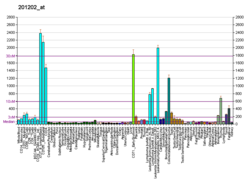 | | More reference expression data |
|
| Ortolozi |
|---|
| Vrste | Čovek | Miš |
|---|
| Entrez | | |
|---|
| Ensembl | | |
|---|
| UniProt | | |
|---|
| RefSeq (mRNA) | | |
|---|
| RefSeq (protein) | | |
|---|
| Location (UCSC) | n/a | n/a |
|---|
| PubMed search | n/a | n/a |
|---|
| Wikidata |
|
Proliferativni ćelijski nuklearni antigen (PCNA) je DNK stega koja deluje kao faktor procesivnosti za DNK polimerazu δ u eukariotskim ćelijama i koja je esencijalna za replikaciju. PCNA je homotrimer koji ostvaruje svoju procesivnost putem obuhvatanja DNK, pri čemu ona deluje kao osnova na kojoj se vezuju drugi proteini koji su neophodni za DNK replikaciju, DNK popravku, remodelovanje hromatina i epigenetiku.[1]
Mnogi proteini formiraju interakcije sa dva poznata PCNA-interagujuća motiva: PCNA interagujuća peptidna (PIP) kutija[2] i AlkB homolog 2 PCNA interagujući motiv (APIM).[3] Proteinsko vezivanje za PCNA putem PIP-kutije se uglavnom ostvaruje tokom DNK replikacije, dok su proteini koji se vezuju za PCNA putem APIM prvenstveno važni u kontekstu genotoksičnog stresa.[4]
U responsu na DNK oštećenje, ovaj protein biva ubikvitinisan i učestvuje u putu RAD6 zavisne DNK popravke. Poznate su dve transkriptne varijante koje kodiraju isti protein. Pseudogeni ovog gena su prisutni na hromozomu 4 i na X hromozomu.[5]
Interakcije
PCNA formira interakcije sa:
- Aneksin A2,[6]
- CAF-1,[7][8][9]
- CDC25C,[10]
- CHTF18,[6]
- Ciklin D1,[11][12]
- Ciklin O,[6][13]
- Cyclin-dependent kinase 4,[12][14]
- Ciklin-dependent kinase inhibitor 1C,[15]
- DNMT1,[16][17][18]
- EP300,[19]
- Endonukleaza 1 specifična za flap strukturu,[20][21][22][23][24][25][26]
- GADD45A,[27][28][29][30][31]
- GADD45G,[32][33]
- HDAC1,[34]
- HUS1,[35]
- ING1,[36]
- KCTD13,[37]
- KIAA0101,[26]
- Ku70,[6][38]
- Ku80,[6][38][39]
- MCL1,[40]
- MSH3,[6][41][42]
- MSH6,[6][41][42]
- MUTYH,[43]
- P21,[15][22][26][44][45][46][47][48]
- POLD2,[49]
- POLD3,[6][50]
- POLDIP2,[51]
- POLH,[52]
- POLL,[53][54][55]
- RFC1,[6][44][56][57][58]
- RFC2,[6][59][60]
- RFC3,[6][61]
- RFC4,[6][59]
- RFC5,[6][57][59]
- Ubikvitin C[62][63][64]
- ATP zavisna helikaza vernerovog sindroma,[65][66]
- XRCC1,[67] and
- Protein 1 vezivanja Y kutije.[68]
Proteini koji formiraju interakcije sa PCNA preko APIM obuhvataju ljudski AlkB homolog 2, TFIIS-L, TFII-I, Rad51B,[3] XPA,[69] ZRANB3,[70] i FBH1.[71]
Reference
- ^ Moldovan, GL; Pfander, B; Jentsch, S (18. 5. 2007). „PCNA, the maestro of the replication fork.”. Cell. 129 (4): 665—79. PMID 17512402. doi:10.1016/j.cell.2007.05.003.
- ^ Warbrick, E (1998). „PCNA binding through a conserved motif.”. BioEssays : news and reviews in molecular, cellular and developmental biology. 20 (3): 195—9. PMID 9631646. doi:10.1002/(sici)1521-1878(199803)20:3<195::aid-bies2>3.0.co;2-r.
- ^ а б Gilljam, KM; Feyzi, E; Aas, PA; Sousa, MM; Müller, R; Vågbø, CB; Catterall, TC; Liabakk, NB; Slupphaug, G; Drabløs, F; Krokan, HE; Otterlei, M (7. 9. 2009). „Identification of a novel, widespread, and functionally important PCNA-binding motif.”. The Journal of cell biology. 186 (5): 645—54. PMID 19736315. doi:10.1083/jcb.200903138.
- ^ Mailand, N; Gibbs-Seymour, I; Bekker-Jensen, S (2013). „Regulation of PCNA-protein interactions for genome stability.”. Nature reviews. Molecular cell biology. 14 (5): 269—82. PMID 23594953. doi:10.1038/nrm3562.
- ^ „Entrez Gene: PCNA proliferating cell nuclear antigen”.
- ^ а б в г д ђ е ж з и ј к л Ohta S, Shiomi Y, Sugimoto K, Obuse C, Tsurimoto T (2002). „A proteomics approach to identify proliferating cell nuclear antigen (PCNA)-binding proteins in human cell lysates. Identification of the human CHL12/RFCs2-5 complex as a novel PCNA-binding protein”. J. Biol. Chem. 277 (43): 40362—7. PMID 12171929. doi:10.1074/jbc.M206194200.
- ^ Zhang K, Gao Y, Li J, Burgess R, Han J, Liang H, Zhang Z, Liu Y (2016). „A DNA binding winged helix domain in CAF-1 functions with PCNA to stabilize CAF-1 at replication forks”. Nucleic Acids Research. 44 (11): 5083—94. PMC 4914081
 . PMID 26908650. doi:10.1093/nar/gkw106.
. PMID 26908650. doi:10.1093/nar/gkw106. - ^ Moggs JG, Grandi P, Quivy JP, Jónsson ZO, Hübscher U, Becker PB, Almouzni G (2000). „A CAF-1-PCNA-mediated chromatin assembly pathway triggered by sensing DNA damage”. Molecular and Cellular Biology. 20 (4): 1206—18. PMC 85246
 . PMID 10648606.
. PMID 10648606. - ^ Rolef Ben-Shahar T, Castillo AG, Osborne MJ, Borden KL, Kornblatt J, Verreault A (2009). „Two fundamentally distinct PCNA interaction peptides contribute to chromatin assembly factor 1 function”. Molecular and Cellular Biology. 29 (24): 6353—65. PMC 2786881
 . PMID 19822659. doi:10.1128/MCB.01051-09.
. PMID 19822659. doi:10.1128/MCB.01051-09. - ^ Kawabe T, Suganuma M, Ando T, Kimura M, Hori H, Okamoto T (2002). „Cdc25C interacts with PCNA at G2/M transition”. Oncogene. 21 (11): 1717—26. PMID 11896603. doi:10.1038/sj.onc.1205229.
- ^ Matsuoka S, Yamaguchi M, Matsukage A (1994). „D-type cyclin-binding regions of proliferating cell nuclear antigen”. J. Biol. Chem. 269 (15): 11030—6. PMID 7908906.
- ^ а б Xiong Y, Zhang H, Beach D (1993). „Subunit rearrangement of the cyclin-dependent kinases is associated with cellular transformation”. Genes Dev. 7 (8): 1572—83. PMID 8101826. doi:10.1101/gad.7.8.1572.
- ^ Otterlei M, Warbrick E, Nagelhus TA, Haug T, Slupphaug G, Akbari M, Aas PA, Steinsbekk K, Bakke O, Krokan HE (1999). „Post-replicative base excision repair in replication foci”. EMBO J. 18 (13): 3834—44. PMC 1171460
 . PMID 10393198. doi:10.1093/emboj/18.13.3834.
. PMID 10393198. doi:10.1093/emboj/18.13.3834. - ^ Serrano M, Hannon GJ, Beach D (1993). „A new regulatory motif in cell-cycle control causing specific inhibition of cyclin D/CDK4”. Nature. 366 (6456): 704—7. PMID 8259215. doi:10.1038/366704a0.
- ^ а б Watanabe H, Pan ZQ, Schreiber-Agus N, DePinho RA, Hurwitz J, Xiong Y (1998). „Suppression of cell transformation by the cyclin-dependent kinase inhibitor p57KIP2 requires binding to proliferating cell nuclear antigen”. Proc. Natl. Acad. Sci. U.S.A. 95 (4): 1392—7. PMC 19016
 . PMID 9465025. doi:10.1073/pnas.95.4.1392.
. PMID 9465025. doi:10.1073/pnas.95.4.1392. - ^ Rountree MR, Bachman KE, Baylin SB (2000). „DNMT1 binds HDAC2 and a new co-repressor, DMAP1, to form a complex at replication foci”. Nat. Genet. 25 (3): 269—77. PMID 10888872. doi:10.1038/77023.
- ^ Iida T, Suetake I, Tajima S, Morioka H, Ohta S, Obuse C, Tsurimoto T (2002). „PCNA clamp facilitates action of DNA cytosine methyltransferase 1 on hemimethylated DNA”. Genes Cells. 7 (10): 997—1007. PMID 12354094. doi:10.1046/j.1365-2443.2002.00584.x.
- ^ Chuang LS, Ian HI, Koh TW, Ng HH, Xu G, Li BF (1997). „Human DNA-(cytosine-5) methyltransferase-PCNA complex as a target for p21WAF1”. Science. 277 (5334): 1996—2000. PMID 9302295. doi:10.1126/science.277.5334.1996.
- ^ Hasan S, Hassa PO, Imhof R, Hottiger MO (2001). „Transcription coactivator p300 binds PCNA and may have a role in DNA repair synthesis”. Nature. 410 (6826): 387—91. PMID 11268218. doi:10.1038/35066610.
- ^ Henneke G, Koundrioukoff S, Hübscher U (2003). „Phosphorylation of human Fen1 by cyclin-dependent kinase modulates its role in replication fork regulation”. Oncogene. 22 (28): 4301—13. PMID 12853968. doi:10.1038/sj.onc.1206606.
- ^ Hasan S, Stucki M, Hassa PO, Imhof R, Gehrig P, Hunziker P, Hübscher U, Hottiger MO (2001). „Regulation of human flap endonuclease-1 activity by acetylation through the transcriptional coactivator p300”. Mol. Cell. 7 (6): 1221—31. PMID 11430825. doi:10.1016/s1097-2765(01)00272-6.
- ^ а б Jónsson ZO, Hindges R, Hübscher U (1998). „Regulation of DNA replication and repair proteins through interaction with the front side of proliferating cell nuclear antigen”. EMBO J. 17 (8): 2412—25. PMC 1170584
 . PMID 9545252. doi:10.1093/emboj/17.8.2412.
. PMID 9545252. doi:10.1093/emboj/17.8.2412. - ^ Gary R, Ludwig DL, Cornelius HL, MacInnes MA, Park MS (1997). „The DNA repair endonuclease XPG binds to proliferating cell nuclear antigen (PCNA) and shares sequence elements with the PCNA-binding regions of FEN-1 and cyclin-dependent kinase inhibitor p21”. J. Biol. Chem. 272 (39): 24522—9. PMID 9305916. doi:10.1074/jbc.272.39.24522.
- ^ Chen U, Chen S, Saha P, Dutta A (1996). „p21Cip1/Waf1 disrupts the recruitment of human Fen1 by proliferating-cell nuclear antigen into the DNA replication complex”. Proc. Natl. Acad. Sci. U.S.A. 93 (21): 11597—602. PMC 38103
 . PMID 8876181. doi:10.1073/pnas.93.21.11597.
. PMID 8876181. doi:10.1073/pnas.93.21.11597. - ^ Dianova II, Bohr VA, Dianov GL (2001). „Interaction of human AP endonuclease 1 with flap endonuclease 1 and proliferating cell nuclear antigen involved in long-patch base excision repair”. Biochemistry. 40 (42): 12639—44. PMID 11601988. doi:10.1021/bi011117i.
- ^ а б в Yu P, Huang B, Shen M, Lau C, Chan E, Michel J, Xiong Y, Payan DG, Luo Y (2001). „p15(PAF), a novel PCNA associated factor with increased expression in tumor tissues”. Oncogene. 20 (4): 484—9. PMID 11313979. doi:10.1038/sj.onc.1204113.
- ^ Smith ML, Chen IT, Zhan Q, Bae I, Chen CY, Gilmer TM, Kastan MB, O'Connor PM, Fornace AJ (1994). „Interaction of the p53-regulated protein Gadd45 with proliferating cell nuclear antigen”. Science. 266 (5189): 1376—80. PMID 7973727. doi:10.1126/science.7973727.
- ^ Chen IT, Smith ML, O'Connor PM, Fornace AJ (1995). „Direct interaction of Gadd45 with PCNA and evidence for competitive interaction of Gadd45 and p21Waf1/Cip1 with PCNA”. Oncogene. 11 (10): 1931—7. PMID 7478510.
- ^ Vairapandi M, Azam N, Balliet AG, Hoffman B, Liebermann DA (2000). „Characterization of MyD118, Gadd45, and proliferating cell nuclear antigen (PCNA) interacting domains. PCNA impedes MyD118 AND Gadd45-mediated negative growth control”. J. Biol. Chem. 275 (22): 16810—9. PMID 10828065. doi:10.1074/jbc.275.22.16810.
- ^ Hall PA, Kearsey JM, Coates PJ, Norman DG, Warbrick E, Cox LS (1995). „Characterisation of the interaction between PCNA and Gadd45”. Oncogene. 10 (12): 2427—33. PMID 7784094.
- ^ Yang Q, Manicone A, Coursen JD, Linke SP, Nagashima M, Forgues M, Wang XW (2000). „Identification of a functional domain in a GADD45-mediated G2/M checkpoint”. J. Biol. Chem. 275 (47): 36892—8. PMID 10973963. doi:10.1074/jbc.M005319200.
- ^ Azam N, Vairapandi M, Zhang W, Hoffman B, Liebermann DA (2001). „Interaction of CR6 (GADD45gamma ) with proliferating cell nuclear antigen impedes negative growth control”. J. Biol. Chem. 276 (4): 2766—74. PMID 11022036. doi:10.1074/jbc.M005626200.
- ^ Nakayama K, Hara T, Hibi M, Hirano T, Miyajima A (1999). „A novel oncostatin M-inducible gene OIG37 forms a gene family with MyD118 and GADD45 and negatively regulates cell growth”. J. Biol. Chem. 274 (35): 24766—72. PMID 10455148. doi:10.1074/jbc.274.35.24766.
- ^ Milutinovic S, Zhuang Q, Szyf M (2002). „Proliferating cell nuclear antigen associates with histone deacetylase activity, integrating DNA replication and chromatin modification”. J. Biol. Chem. 277 (23): 20974—8. PMID 11929879. doi:10.1074/jbc.M202504200.
- ^ Komatsu K, Wharton W, Hang H, Wu C, Singh S, Lieberman HB, Pledger WJ, Wang HG (2000). „PCNA interacts with hHus1/hRad9 in response to DNA damage and replication inhibition”. Oncogene. 19 (46): 5291—7. PMID 11077446. doi:10.1038/sj.onc.1203901.
- ^ Scott M, Bonnefin P, Vieyra D, Boisvert FM, Young D, Bazett-Jones DP, Riabowol K (2001). „UV-induced binding of ING1 to PCNA regulates the induction of apoptosis”. J. Cell. Sci. 114 (Pt 19): 3455—62. PMID 11682605.
- ^ He H, Tan CK, Downey KM, So AG (2001). „A tumor necrosis factor alpha- and interleukin 6-inducible protein that interacts with the small subunit of DNA polymerase delta and proliferating cell nuclear antigen”. Proc. Natl. Acad. Sci. U.S.A. 98 (21): 11979—84. PMC 59753
 . PMID 11593007. doi:10.1073/pnas.221452098.
. PMID 11593007. doi:10.1073/pnas.221452098. - ^ а б Balajee AS, Geard CR (2001). „Chromatin-bound PCNA complex formation triggered by DNA damage occurs independent of the ATM gene product in human cells”. Nucleic Acids Res. 29 (6): 1341—51. PMC 29758
 . PMID 11239001. doi:10.1093/nar/29.6.1341.
. PMID 11239001. doi:10.1093/nar/29.6.1341. - ^ Matheos D, Ruiz MT, Price GB, Zannis-Hadjopoulos M (2002). „Ku antigen, an origin-specific binding protein that associates with replication proteins, is required for mammalian DNA replication”. Biochim. Biophys. Acta. 1578 (1–3): 59—72. PMID 12393188. doi:10.1016/s0167-4781(02)00497-9.
- ^ Fujise K, Zhang D, Liu J, Yeh ET (2000). „Regulation of apoptosis and cell cycle progression by MCL1. Differential role of proliferating cell nuclear antigen”. J. Biol. Chem. 275 (50): 39458—65. PMID 10978339. doi:10.1074/jbc.M006626200.
- ^ а б Kleczkowska HE, Marra G, Lettieri T, Jiricny J (2001). „hMSH3 and hMSH6 interact with PCNA and colocalize with it to replication foci”. Genes Dev. 15 (6): 724—36. PMC 312660
 . PMID 11274057. doi:10.1101/gad.191201.
. PMID 11274057. doi:10.1101/gad.191201. - ^ а б Clark AB, Valle F, Drotschmann K, Gary RK, Kunkel TA (2000). „Functional interaction of proliferating cell nuclear antigen with MSH2-MSH6 and MSH2-MSH3 complexes”. J. Biol. Chem. 275 (47): 36498—501. PMID 11005803. doi:10.1074/jbc.C000513200.
- ^ Parker A, Gu Y, Mahoney W, Lee SH, Singh KK, Lu AL (2001). „Human homolog of the MutY repair protein (hMYH) physically interacts with proteins involved in long patch DNA base excision repair”. J. Biol. Chem. 276 (8): 5547—55. PMID 11092888. doi:10.1074/jbc.M008463200.
- ^ а б Fotedar R, Mossi R, Fitzgerald P, Rousselle T, Maga G, Brickner H, Messier H, Kasibhatla S, Hübscher U, Fotedar A (1996). „A conserved domain of the large subunit of replication factor C binds PCNA and acts like a dominant negative inhibitor of DNA replication in mammalian cells”. EMBO J. 15 (16): 4423—33. PMC 452166
 . PMID 8861969.
. PMID 8861969. - ^ Rual JF, Venkatesan K, Hao T, Hirozane-Kishikawa T, Dricot A, Li N, Berriz GF, Gibbons FD, Dreze M, Ayivi-Guedehoussou N, Klitgord N, Simon C, Boxem M, Milstein S, Rosenberg J, Goldberg DS, Zhang LV, Wong SL, Franklin G, Li S, Albala JS, Lim J, Fraughton C, Llamosas E, Cevik S, Bex C, Lamesch P, Sikorski RS, Vandenhaute J, Zoghbi HY, Smolyar A, Bosak S, Sequerra R, Doucette-Stamm L, Cusick ME, Hill DE, Roth FP, Vidal M (2005). „Towards a proteome-scale map of the human protein-protein interaction network”. Nature. 437 (7062): 1173—8. PMID 16189514. doi:10.1038/nature04209.
- ^ Frouin I, Maga G, Denegri M, Riva F, Savio M, Spadari S, Prosperi E, Scovassi AI (2003). „Human proliferating cell nuclear antigen, poly(ADP-ribose) polymerase-1, and p21waf1/cip1. A dynamic exchange of partners”. J. Biol. Chem. 278 (41): 39265—8. PMID 12930846. doi:10.1074/jbc.C300098200.
- ^ Gulbis JM, Kelman Z, Hurwitz J, O'Donnell M, Kuriyan J (1996). „Structure of the C-terminal region of p21(WAF1/CIP1) complexed with human PCNA”. Cell. 87 (2): 297—306. PMID 8861913. doi:10.1016/s0092-8674(00)81347-1.
- ^ Touitou R, Richardson J, Bose S, Nakanishi M, Rivett J, Allday MJ (2001). „A degradation signal located in the C-terminus of p21WAF1/CIP1 is a binding site for the C8 alpha-subunit of the 20S proteasome”. EMBO J. 20 (10): 2367—75. PMC 125454
 . PMID 11350925. doi:10.1093/emboj/20.10.2367.
. PMID 11350925. doi:10.1093/emboj/20.10.2367. - ^ Lu X, Tan CK, Zhou JQ, You M, Carastro LM, Downey KM, So AG (2002). „Direct interaction of proliferating cell nuclear antigen with the small subunit of DNA polymerase delta”. J. Biol. Chem. 277 (27): 24340—5. PMID 11986310. doi:10.1074/jbc.M200065200.
- ^ Ducoux M, Urbach S, Baldacci G, Hübscher U, Koundrioukoff S, Christensen J, Hughes P (2001). „Mediation of proliferating cell nuclear antigen (PCNA)-dependent DNA replication through a conserved p21(Cip1)-like PCNA-binding motif present in the third subunit of human DNA polymerase delta”. J. Biol. Chem. 276 (52): 49258—66. PMID 11595739. doi:10.1074/jbc.M106990200.
- ^ Liu L, Rodriguez-Belmonte EM, Mazloum N, Xie B, Lee MY (2003). „Identification of a novel protein, PDIP38, that interacts with the p50 subunit of DNA polymerase delta and proliferating cell nuclear antigen”. J. Biol. Chem. 278 (12): 10041—7. PMID 12522211. doi:10.1074/jbc.M208694200.
- ^ Haracska L, Johnson RE, Unk I, Phillips B, Hurwitz J, Prakash L, Prakash S (2001). „Physical and functional interactions of human DNA polymerase eta with PCNA”. Mol. Cell. Biol. 21 (21): 7199—206. PMC 99895
 . PMID 11585903. doi:10.1128/MCB.21.21.7199-7206.2001.
. PMID 11585903. doi:10.1128/MCB.21.21.7199-7206.2001. - ^ Haracska L, Unk I, Johnson RE, Phillips BB, Hurwitz J, Prakash L, Prakash S (2002). „Stimulation of DNA synthesis activity of human DNA polymerase kappa by PCNA”. Mol. Cell. Biol. 22 (3): 784—91. PMC 133560
 . PMID 11784855. doi:10.1128/mcb.22.3.784-791.2002.
. PMID 11784855. doi:10.1128/mcb.22.3.784-791.2002. - ^ Maga G, Villani G, Ramadan K, Shevelev I, Tanguy Le Gac N, Blanco L, Blanca G, Spadari S, Hübscher U (2002). „Human DNA polymerase lambda functionally and physically interacts with proliferating cell nuclear antigen in normal and translesion DNA synthesis”. J. Biol. Chem. 277 (50): 48434—40. PMID 12368291. doi:10.1074/jbc.M206889200.
- ^ Shimazaki N, Yoshida K, Kobayashi T, Toji S, Tamai K, Koiwai O (2002). „Over-expression of human DNA polymerase lambda in E. coli and characterization of the recombinant enzyme”. Genes Cells. 7 (7): 639—51. PMID 12081642. doi:10.1046/j.1365-2443.2002.00547.x.
- ^ Maruyama T, Farina A, Dey A, Cheong J, Bermudez VP, Tamura T, Sciortino S, Shuman J, Hurwitz J, Ozato K (2002). „A Mammalian bromodomain protein, brd4, interacts with replication factor C and inhibits progression to S phase”. Mol. Cell. Biol. 22 (18): 6509—20. PMC 135621
 . PMID 12192049. doi:10.1128/mcb.22.18.6509-6520.2002.
. PMID 12192049. doi:10.1128/mcb.22.18.6509-6520.2002. - ^ а б Mossi R, Jónsson ZO, Allen BL, Hardin SH, Hübscher U (1997). „Replication factor C interacts with the C-terminal side of proliferating cell nuclear antigen”. J. Biol. Chem. 272 (3): 1769—76. PMID 8999859. doi:10.1074/jbc.272.3.1769.
- ^ van der Kuip H, Carius B, Haque SJ, Williams BR, Huber C, Fischer T (1999). „The DNA-binding subunit p140 of replication factor C is upregulated in cycling cells and associates with G1 phase cell cycle regulatory proteins”. J. Mol. Med. 77 (4): 386—92. PMID 10353443. doi:10.1007/s001090050365.
- ^ а б в Cai J, Gibbs E, Uhlmann F, Phillips B, Yao N, O'Donnell M, Hurwitz J (1997). „A complex consisting of human replication factor C p40, p37, and p36 subunits is a DNA-dependent ATPase and an intermediate in the assembly of the holoenzyme”. J. Biol. Chem. 272 (30): 18974—81. PMID 9228079. doi:10.1074/jbc.272.30.18974.
- ^ Pan ZQ, Chen M, Hurwitz J (1993). „The subunits of activator 1 (replication factor C) carry out multiple functions essential for proliferating-cell nuclear antigen-dependent DNA synthesis”. Proc. Natl. Acad. Sci. U.S.A. 90 (1): 6—10. PMC 45588
 . PMID 8093561. doi:10.1073/pnas.90.1.6.
. PMID 8093561. doi:10.1073/pnas.90.1.6. - ^ Merkle CJ, Karnitz LM, Henry-Sánchez JT, Chen J (2003). „Cloning and characterization of hCTF18, hCTF8, and hDCC1. Human homologs of a Saccharomyces cerevisiae complex involved in sister chromatid cohesion establishment”. J. Biol. Chem. 278 (32): 30051—6. PMID 12766176. doi:10.1074/jbc.M211591200.
- ^ Motegi A, Liaw HJ, Lee KY, Roest HP, Maas A, Wu X, Moinova H, Markowitz SD, Ding H, Hoeijmakers JH, Myung K (2008). „Polyubiquitination of proliferating cell nuclear antigen by HLTF and SHPRH prevents genomic instability from stalled replication forks”. Proc. Natl. Acad. Sci. U.S.A. 105 (34): 12411—6. PMC 2518831
 . PMID 18719106. doi:10.1073/pnas.0805685105.
. PMID 18719106. doi:10.1073/pnas.0805685105. - ^ Unk I, Hajdú I, Fátyol K, Hurwitz J, Yoon JH, Prakash L, Prakash S, Haracska L (2008). „Human HLTF functions as a ubiquitin ligase for proliferating cell nuclear antigen polyubiquitination”. Proc. Natl. Acad. Sci. U.S.A. 105 (10): 3768—73. PMC 2268824
 . PMID 18316726. doi:10.1073/pnas.0800563105.
. PMID 18316726. doi:10.1073/pnas.0800563105. - ^ Brun J, Chiu R, Lockhart K, Xiao W, Wouters BG, Gray DA (2008). „hMMS2 serves a redundant role in human PCNA polyubiquitination”. BMC Mol. Biol. 9: 24. PMC 2263069
 . PMID 18284681. doi:10.1186/1471-2199-9-24.
. PMID 18284681. doi:10.1186/1471-2199-9-24. - ^ Rodríguez-López AM, Jackson DA, Nehlin JO, Iborra F, Warren AV, Cox LS (2003). „Characterisation of the interaction between WRN, the helicase/exonuclease defective in progeroid Werner's syndrome, and an essential replication factor, PCNA”. Mech. Ageing Dev. 124 (2): 167—74. PMID 12633936. doi:10.1016/s0047-6374(02)00131-8.
- ^ Huang S, Beresten S, Li B, Oshima J, Ellis NA, Campisi J (2000). „Characterization of the human and mouse WRN 3'-->5' exonuclease”. Nucleic Acids Res. 28 (12): 2396—405. PMC 102739
 . PMID 10871373. doi:10.1093/nar/28.12.2396.
. PMID 10871373. doi:10.1093/nar/28.12.2396. - ^ Fan J, Otterlei M, Wong HK, Tomkinson AE, Wilson DM (2004). „XRCC1 co-localizes and physically interacts with PCNA”. Nucleic Acids Res. 32 (7): 2193—201. PMC 407833
 . PMID 15107487. doi:10.1093/nar/gkh556.
. PMID 15107487. doi:10.1093/nar/gkh556. - ^ Ise T, Nagatani G, Imamura T, Kato K, Takano H, Nomoto M, Izumi H, Ohmori H, Okamoto T, Ohga T, Uchiumi T, Kuwano M, Kohno K (1999). „Transcription factor Y-box binding protein 1 binds preferentially to cisplatin-modified DNA and interacts with proliferating cell nuclear antigen”. Cancer Res. 59 (2): 342—6. PMID 9927044.
- ^ Gilljam KM, Müller R, Liabakk NB, Otterlei M (2012). „Nucleotide excision repair is associated with the replisome and its efficiency depends on a direct interaction between XPA and PCNA.”. PLoS ONE. 7 (11): e49199. PMC 3496702
 . PMID 23152873. doi:10.1371/journal.pone.0049199.
. PMID 23152873. doi:10.1371/journal.pone.0049199. - ^ Ciccia A, Nimonkar AV, Hu Y, Hajdu I, Achar YJ, Izhar L, Petit SA, Adamson B, Yoon JC, Kowalczykowski SC, Livingston DM, Haracska L, Elledge SJ (10. 8. 2012). „Polyubiquitinated PCNA recruits the ZRANB3 translocase to maintain genomic integrity after replication stress.”. Molecular Cell. 47 (3): 396—409. PMC 3613862
 . PMID 22704558. doi:10.1016/j.molcel.2012.05.024.
. PMID 22704558. doi:10.1016/j.molcel.2012.05.024. - ^ Bacquin A, Pouvelle C, Siaud N, Perderiset M, Salomé-Desnoulez S, Tellier-Lebegue C, Lopez B, Charbonnier JB, Kannouche PL (2013). „The helicase FBH1 is tightly regulated by PCNA via CRL4(Cdt2)-mediated proteolysis in human cells.”. Nucleic Acids Research. 41 (13): 6501—13. PMC 3711418
 . PMID 23677613. doi:10.1093/nar/gkt397.
. PMID 23677613. doi:10.1093/nar/gkt397.
Literatura
- Prosperi E (1998). „Multiple roles of the proliferating cell nuclear antigen: DNA replication, repair and cell cycle control”. Progress in cell cycle research. 3: 193—210. ISBN 978-1-4613-7451-0. PMID 9552415. doi:10.1007/978-1-4615-5371-7_15.
- Miura M (1999). „Detection of chromatin-bound PCNA in mammalian cells and its use to study DNA excision repair”. J. Radiat. Res. 40 (1): 1—12. PMID 10408173. doi:10.1269/jrr.40.1.
- Chen M, Pan ZQ, Hurwitz J (1992). „Sequence and expression in Escherichia coli of the 40-kDa subunit of activator 1 (replication factor C) of HeLa cells”. Proc. Natl. Acad. Sci. U.S.A. 89 (7): 2516—2520. PMC 48692
 . PMID 1313560. doi:10.1073/pnas.89.7.2516.
. PMID 1313560. doi:10.1073/pnas.89.7.2516. - Kemeny MM, Alava G, Oliver JM (1993). „Improving responses in hepatomas with circadian-patterned hepatic artery infusions of recombinant interleukin-2”. J. Immunother. 12 (4): 219—223. PMID 1477073. doi:10.1097/00002371-199211000-00001.
- Morris GF, Mathews MB (1990). „Analysis of the proliferating cell nuclear antigen promoter and its response to adenovirus early region 1”. J. Biol. Chem. 265 (27): 16116—25. PMID 1975809.
- Webb G, Parsons P, Chenevix-Trench G (1991). „Localization of the gene for human proliferating nuclear antigen/cyclin by in situ hybridization”. Hum. Genet. 86 (1): 84—6. PMID 1979311. doi:10.1007/bf00205180.
- Travali S, Ku DH, Rizzo MG, Ottavio L, Baserga R, Calabretta B (1989). „Structure of the human gene for the proliferating cell nuclear antigen”. J. Biol. Chem. 264 (13): 7466—72. PMID 2565339.
- Ku DH, Travali S, Calabretta B, Huebner K, Baserga R (1989). „Human gene for proliferating cell nuclear antigen has pseudogenes and localizes to chromosome 20”. Somat. Cell Mol. Genet. 15 (4): 297—307. PMID 2569765. doi:10.1007/BF01534969.
- Prelich G, Kostura M, Marshak DR, Mathews MB, Stillman B (1987). „The cell-cycle regulated proliferating cell nuclear antigen is required for SV40 DNA replication in vitro”. Nature. 326 (6112): 471—5. PMID 2882422. doi:10.1038/326471a0.
- Almendral JM, Huebsch D, Blundell PA, Macdonald-Bravo H, Bravo R (1987). „Cloning and sequence of the human nuclear protein cyclin: homology with DNA-binding proteins”. Proc. Natl. Acad. Sci. U.S.A. 84 (6): 1575—9. PMC 304478
 . PMID 2882507. doi:10.1073/pnas.84.6.1575.
. PMID 2882507. doi:10.1073/pnas.84.6.1575. - Chen IT, Smith ML, O'Connor PM, Fornace AJ (1995). „Direct interaction of Gadd45 with PCNA and evidence for competitive interaction of Gadd45 and p21Waf1/Cip1 with PCNA”. Oncogene. 11 (10): 1931—7. PMID 7478510.
- Li X, Li J, Harrington J, Lieber MR, Burgers PM (1995). „Lagging strand DNA synthesis at the eukaryotic replication fork involves binding and stimulation of FEN-1 by proliferating cell nuclear antigen”. J. Biol. Chem. 270 (38): 22109—12. PMID 7673186. doi:10.1074/jbc.270.38.22109.
- Fukuda K, Morioka H, Imajou S, Ikeda S, Ohtsuka E, Tsurimoto T (1995). „Structure-function relationship of the eukaryotic DNA replication factor, proliferating cell nuclear antigen”. J. Biol. Chem. 270 (38): 22527—34. PMID 7673244. doi:10.1074/jbc.270.38.22527.
- Warbrick E, Lane DP, Glover DM, Cox LS (1995). „A small peptide inhibitor of DNA replication defines the site of interaction between the cyclin-dependent kinase inhibitor p21WAF1 and proliferating cell nuclear antigen”. Curr. Biol. 5 (3): 275—282. PMID 7780738. doi:10.1016/S0960-9822(95)00058-3.
- Hall PA, Kearsey JM, Coates PJ, Norman DG, Warbrick E, Cox LS (1995). „Characterisation of the interaction between PCNA and Gadd45”. Oncogene. 10 (12): 2427—33. PMID 7784094.
- Kato S, Sekine S, Oh SW, Kim NS, Umezawa Y, Abe N, Yokoyama-Kobayashi M, Aoki T (1995). „Construction of a human full-length cDNA bank”. Gene. 150 (2): 243—50. PMID 7821789. doi:10.1016/0378-1119(94)90433-2.
- Matsuoka S, Yamaguchi M, Matsukage A (1994). „D-type cyclin-binding regions of proliferating cell nuclear antigen”. J. Biol. Chem. 269 (15): 11030—6. PMID 7908906.
- Szepesi A, Gelfand EW, Lucas JJ (1994). „Association of proliferating cell nuclear antigen with cyclin-dependent kinases and cyclins in normal and transformed human T lymphocytes”. Blood. 84 (10): 3413—21. PMID 7949095.
- Smith ML, Chen IT, Zhan Q, Bae I, Chen CY, Gilmer TM, Kastan MB, O'Connor PM, Fornace AJ (1994). „Interaction of the p53-regulated protein Gadd45 with proliferating cell nuclear antigen”. Science. 266 (5189): 1376—80. PMID 7973727. doi:10.1126/science.7973727.
- Pan ZQ, Chen M, Hurwitz J (1993). „The subunits of activator 1 (replication factor C) carry out multiple functions essential for proliferating-cell nuclear antigen-dependent DNA synthesis”. Proc. Natl. Acad. Sci. U.S.A. 90 (1): 6—10. PMC 45588
 . PMID 8093561. doi:10.1073/pnas.90.1.6.
. PMID 8093561. doi:10.1073/pnas.90.1.6.
Spoljašnje veze
- PCNA на US National Library of Medicine Medical Subject Headings (MeSH)
- „ANA: Cell cycle related (Mitotic): PCNA type 1 and type 2 Antibody Patterns”. Antibody Patterns.com. Архивирано из оригинала 23. 09. 2015. г. Приступљено 2008-04-15.
- Dan Krotz. „Structure of a clamp–loader complex”. Advanced Light Source News. Lawrence Berkeley National Laboratory. Приступљено 2008-04-15.
- Bowman GD, O'Donnell M, Kuriyan J (2004). „Structural analysis of a eukaryotic sliding DNA clamp-clamp loader complex”. Nature. 429 (6993): 724—730. PMID 15201901. doi:10.1038/nature02585.
- „Movie showing a model of clamp loading of PCNA onto DNA”. Pubmed Central. [мртва веза]
- Miyata T, Suzuki H, Oyama T, Mayanagi K, Ishino Y, Morikawa K (2005). „Open clamp structure in the clamp-loading complex visualized by electron microscopic image analysis”. Proc. Natl. Acad. Sci. U.S.A. 102 (39): 13795—13800. PMC 1236569
 . PMID 16169902. doi:10.1073/pnas.0506447102.
. PMID 16169902. doi:10.1073/pnas.0506447102.
-
1axc: Ljudski PCNA -
1u76: Kristalna struktura hPCNA vezanog za ostatke 452-466 DNK polimeraze-delta, p66 podjedinice -
1u7b: Kristalna struktura hPCNA vezanog za ostatke 331-350 flap endonukleaze-1 (FEN1) -
1ul1: Kristalna struktura ljudskog FEN1-PCNA kompleksa -
1vyj: Strukturene i biohemijske studije ljudskog PCNA kompleksa pružaju bazu za asocijaciju sa CDK/CYCLIN -
1vym: Prirodna ljudska PCNA -
1w60: Prirodna ljudska PCNA |
|
|---|
Separacija
i inicijacija | Prokariotska
(inicijacija) | |
|---|
Eukariotska
(priprema u
G1 fazi) | |
|---|
| Oba | |
|---|
|
|---|
| Replikacija | Prokariotska
(elongacija) | DNK polimeraza III holoenzim ( dnaC, dnaE, dnaH, dnaN, dnaQ, dnaT, dnaX, holA, holB, holC, holD, holE) · Replizom · DNK ligaza · DNK stega · Topoizomeraza ( DNK giraza) Prokariotska DNK polimeraza: DNK polimeraza I ( Klenov fragment) |
|---|
Eukariotska
(sinteza u
S fazi) | |
|---|
| Oba | |
|---|
|
|---|
| Terminacija | |
|---|
B bsyn: dnk (repl, cycl, reco, repr) · tscr (fact, tcrg, nucl, rnat, rept, ptts) · tltn (risu, pttl, nexn) · dnab, rnab/runp · stru (domn, 1°, 2°, 3°, 4°) |
 . PMID 26908650. doi:10.1093/nar/gkw106.
. PMID 26908650. doi:10.1093/nar/gkw106.  . PMID 10648606.
. PMID 10648606.  . PMID 19822659. doi:10.1128/MCB.01051-09.
. PMID 19822659. doi:10.1128/MCB.01051-09.  . PMID 10393198. doi:10.1093/emboj/18.13.3834.
. PMID 10393198. doi:10.1093/emboj/18.13.3834.  . PMID 9465025. doi:10.1073/pnas.95.4.1392.
. PMID 9465025. doi:10.1073/pnas.95.4.1392.  . PMID 9545252. doi:10.1093/emboj/17.8.2412.
. PMID 9545252. doi:10.1093/emboj/17.8.2412.  . PMID 8876181. doi:10.1073/pnas.93.21.11597.
. PMID 8876181. doi:10.1073/pnas.93.21.11597.  . PMID 11593007. doi:10.1073/pnas.221452098.
. PMID 11593007. doi:10.1073/pnas.221452098.  . PMID 11239001. doi:10.1093/nar/29.6.1341.
. PMID 11239001. doi:10.1093/nar/29.6.1341.  . PMID 11274057. doi:10.1101/gad.191201.
. PMID 11274057. doi:10.1101/gad.191201.  . PMID 8861969.
. PMID 8861969.  . PMID 11350925. doi:10.1093/emboj/20.10.2367.
. PMID 11350925. doi:10.1093/emboj/20.10.2367.  . PMID 11585903. doi:10.1128/MCB.21.21.7199-7206.2001.
. PMID 11585903. doi:10.1128/MCB.21.21.7199-7206.2001.  . PMID 11784855. doi:10.1128/mcb.22.3.784-791.2002.
. PMID 11784855. doi:10.1128/mcb.22.3.784-791.2002.  . PMID 12192049. doi:10.1128/mcb.22.18.6509-6520.2002.
. PMID 12192049. doi:10.1128/mcb.22.18.6509-6520.2002.  . PMID 8093561. doi:10.1073/pnas.90.1.6.
. PMID 8093561. doi:10.1073/pnas.90.1.6.  . PMID 18719106. doi:10.1073/pnas.0805685105.
. PMID 18719106. doi:10.1073/pnas.0805685105.  . PMID 18316726. doi:10.1073/pnas.0800563105.
. PMID 18316726. doi:10.1073/pnas.0800563105.  . PMID 18284681. doi:10.1186/1471-2199-9-24.
. PMID 18284681. doi:10.1186/1471-2199-9-24.  . PMID 10871373. doi:10.1093/nar/28.12.2396.
. PMID 10871373. doi:10.1093/nar/28.12.2396.  . PMID 15107487. doi:10.1093/nar/gkh556.
. PMID 15107487. doi:10.1093/nar/gkh556.  . PMID 23152873. doi:10.1371/journal.pone.0049199.
. PMID 23152873. doi:10.1371/journal.pone.0049199.  . PMID 22704558. doi:10.1016/j.molcel.2012.05.024.
. PMID 22704558. doi:10.1016/j.molcel.2012.05.024.  . PMID 23677613. doi:10.1093/nar/gkt397.
. PMID 23677613. doi:10.1093/nar/gkt397.  . PMID 1313560. doi:10.1073/pnas.89.7.2516.
. PMID 1313560. doi:10.1073/pnas.89.7.2516.  . PMID 2882507. doi:10.1073/pnas.84.6.1575.
. PMID 2882507. doi:10.1073/pnas.84.6.1575.  . PMID 8093561. doi:10.1073/pnas.90.1.6.
. PMID 8093561. doi:10.1073/pnas.90.1.6.  . PMID 16169902. doi:10.1073/pnas.0506447102.
. PMID 16169902. doi:10.1073/pnas.0506447102.  1axc: Ljudski PCNA
1axc: Ljudski PCNA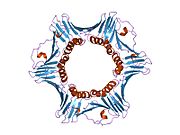 1u76: Kristalna struktura hPCNA vezanog za ostatke 452-466 DNK polimeraze-delta, p66 podjedinice
1u76: Kristalna struktura hPCNA vezanog za ostatke 452-466 DNK polimeraze-delta, p66 podjedinice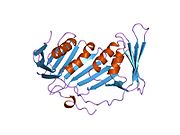 1u7b: Kristalna struktura hPCNA vezanog za ostatke 331-350 flap endonukleaze-1 (FEN1)
1u7b: Kristalna struktura hPCNA vezanog za ostatke 331-350 flap endonukleaze-1 (FEN1)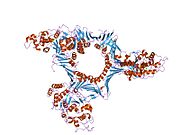 1ul1: Kristalna struktura ljudskog FEN1-PCNA kompleksa
1ul1: Kristalna struktura ljudskog FEN1-PCNA kompleksa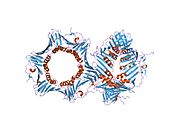 1vyj: Strukturene i biohemijske studije ljudskog PCNA kompleksa pružaju bazu za asocijaciju sa CDK/CYCLIN
1vyj: Strukturene i biohemijske studije ljudskog PCNA kompleksa pružaju bazu za asocijaciju sa CDK/CYCLIN 1vym: Prirodna ljudska PCNA
1vym: Prirodna ljudska PCNA 1w60: Prirodna ljudska PCNA
1w60: Prirodna ljudska PCNA













